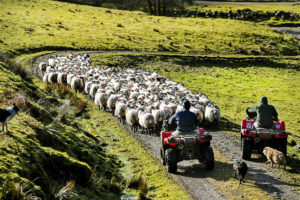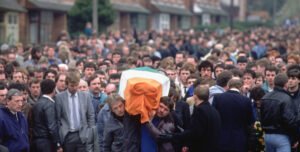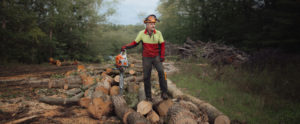A few months ago, driven by some romantic impulse, I moved my family into a derelict farmhouse on a steep and remote Ulster hillside, recreating a rural Irish lifestyle my maternal grandparents eagerly fled at the first possible opportunity. Visiting neighbours, after they have patted the house’s largely solid stonework and tutted at the lack of amenities, almost uniformly advise me to knock it down and start again: the masochistic urge to inhabit a picturesque ruin is, after all, a very English trait.
But there is something elemental, beyond rational considerations, in the appeal of the Irish cottage. Few were the Irish emigrant homes of a certain era that didn’t have a framed farmstead hanging on the sitting room wall, whitewash sparkling against the Kodacolor green. A symbol of a simpler, harder lifestyle, simultaneously fetishished and spurned, the Irish farmstead, built from rubble from its surrounding fields, conveys deep, ambivalent realms of meaning, quite distinct from and darker than the prettily uncomplicated charms of the chocolate-box English cottage. Empty farmhouses, which in England would each be spick and span with Farrow and Ball, litter Northern Ireland’s countryside like abandoned crime scenes. In Ireland, the rural cottage still lurks in the imagination like a half-remembered, troubling dream.
It is no surprise, then, that houses loom large in Ireland’s cultural production. Indeed, it is only partly an exaggeration to say that Irish literature — at least in English — consists of a collection of domestic metaphors. In an island whose history has been defined by contested land ownership, houses dominate the country’s literary landscape like an Anglo-Irish “Big House” overlooking its demesne.
From the very birth of the Anglo-Irish novel, with Maria Edgeworth’s Castle Rackrent (1800) and The Absentee (1812), the Big House of the landlords was presented as a mouldering, moss-streaked metaphor for the country’s social and political order, a literary premonition of the gloomily decaying wrecks of the 20th-century Anglo-Irish novel, their shrubbery haunted by rebellious tenants and doomed to fiery dissolution. Even Bram Stoker, giving his imagination the freest rein, was compelled to conjure up a landlord, surrounded by superstitious peasants, vacating his crumbling mansion in a box of his native soil, while casting an acquisitive eye on the London property market.
On the other side of Ireland’s great political divide, the idealised peasant cottage of early 20th-century Irish nationalism, successor to the squalid 19th-century tenant cabin, marks the point at which improved economic conditions following the Famine laid the foundations for Ireland’s separation from its negligent neighbouring freeholder. The tidy, homely cottage became the moral and political contrast to the ramshackle and disorderly Big House, just as independent Ireland was to draw from its own native folk resources in establishing itself as a nation once again.
But one man’s bucolic fantasy is another’s nightmare. Ulster Unionist election posters contrasted the tidily prosperous farmsteads of the Protestant statelet with the tumbledown thatched cabins of De Valera’s Republic — relying on cultural tropes that, ironically, only make sense within an Irish context. The dominant stage of post-independence Realist literature — the isolated Midlands farmhouse ruled by a fallible, domineering father — provided a handy metaphor for writers chafing against the stultifying claustrophobia of mid-20th century Ireland. In today’s neurotically globalising Republic, scene of a housing crisis that makes Britain’s Generation Rent look comparatively blessed, the abandoned estates of the Celtic Tiger boom fulfil a similar purpose: they are vacant symbols of a country caught between outward-looking aspirations and the material reality of a marginal country on Europe’s westernmost fringe.
But here in Northern Ireland, a century after the border uncurled itself across Ulster’s rainy country lanes, this domestic metaphor has its own specific, harder edge. As bookseller-turned-writer Alexander Poots observes in The Stranger’s House, his excellent new book on Northern Irish writing, David Trimble instinctively returned to the trope in his Nobel Peace Prize acceptance speech, proclaiming that “‘Ulster Unionists, fearful of being isolated on the island, built a solid house, but it was a cold house for Catholics. And northern Nationalists, although they had a roof over their heads, seemed to us as if they meant to burn the house down.” A solid house built on uncertain ground, now Northern Ireland’s knife-edge demographic balance is shifting back in turn, looking to wash the state’s foundations away with it.
The politics and culture of Northern Ireland, Britain’s neglected stepchild over the water, are after all defined by one great building project, 400 years ago. Until the early 17th-century plantation of British Protestant settlers, Ulster was the wildest of Ireland’s four provinces, the last holdout of the old Gaelic order, and the least influenced by English culture. Over the course of a century, reshaped by its new population, it became the most distinctively British corner of the island, farms and sturdy grey market towns, in mainland style, blooming like mushrooms on Ulster’s levelled woodlands. Like a family’s private ways of speech, the shared dialect of its two peoples is still rich with the expressive Germanic vocabulary of the Scots colonists: people still hoke and boke, they gulder and gurn in the linguistic residue of “the Hamely Tongue”. Forced into loveless cohabitation by history, the province’s two nations have explored their predicament, in literature, through the image of the uneasily shared home.
In Reading in the Dark (1996), the Catholic writer Seamus Deane layers two oppressive domestic metaphors on top of each other: the claustrophobic Derry two-up, two-down where family life is weighed down by dark secrets, and the stolen farmhouse just across the border in Donegal, where a life of bucolic freedom and contentment lies unfairly out of reach. In the Monaghan writer Eugene McCabe’s cycle of fiction set across the border in Northern Ireland’s Fermanagh, the uneasy cohabitation of Catholic and Protestant finds expression in a lush and lurid Ulster Gothic: in Siege (1973), IRA gunmen hold an Anglo-Irish gentry family hostage in their Big House, finding uncomfortable intimacy in their unwillingly shared predicament; in Death and Nightingales (1992), the Catholic stepdaughter of a cuckolded Protestant landlord plots his murder, before being betrayed in turn by his devious Fenian tenant. Most explicitly, in Bill Morrison’s A Love Song for Ulster trilogy (1994), the Catholic Kate, abandoned by her mother as the border closed, is trapped in unwilling domesticity with the Protestant John, prisoner in a cold and isolated Northern farmhouse.
As a consequence of this troubled cohabitation, Poots observes, throughout its century-long existence Northern Irish literature “has seen writer after writer grasp for an elusive home. Inevitably they fail, and that failure becomes the subject of their work. They are all inhabitants of the disappearing island, tenants of the Strangers’ House.” Perhaps it is natural, then, that an unstable hold on uncertain ground pervades much of the province’s writing, a persistent sense that there are stranger things lurking beneath Ulster’s stolid surface. In Northern Irish writing, the hamely always threatens to become unheimlich.
Poots opens with a portrait of three Belfast writers — C.S. Lewis, Forrest Reid, and Louis MacNeice — and the comfortable and unhappy red-brick bourgeois homes that shaped their imaginations. Like their homeland, in their infancy “all had nightmares so memorable that they seemed worthy of record decades after their occurrence”, Poots notes, and “all three men described their childhood nightmares in their respective memoirs”. The triad are strangely interchangeable, Poots observes: “All were Protestants, and while some were more comfortable than others, all were vastly better off than the average Irishman. All had black dreams, all became writers. All knew the dark well.” And like Carson, the statelet’s sceptical founder, all three were repelled by the Loyalist culture of their tribe, “the marching bands, the sashes and banners, the great bonfires lit at midnight on the Twelfth of July”. Lewis, who would write that “if I ever get interested in politics, I shall probably be a nationalist”, described his distaste as simply a “natural repulsion to noisy drum‐beating, bullying Orangemen”.
Instead, for Lewis, in the dim afterglow of Yeats’s Celtic Twilight, escape was to be found in fantasy worlds, a hidden realm where time is so distorted that the ordinary human lifespan extends disorientatingly into mythicised, glorious history. Though Poots notes laconically that “not many people would associate Narnia with Ireland”, this parallel is surely inescapable. As Lewis would write in Surprised by Joy, “the country I grew up in had everything to encourage a romantic bent, had indeed done so ever since I first looked at the unattainable Green Hills through the nursery window”.
Explicitly transposing his beloved Oxford on the Mourne Mountains and Donegal, Narnia was a fantasy Ulster for Lewis, a land of “roaring waterfalls and mossy rocks and echoing caverns”, of “heathery mountains” and “windy slopes alight with gorse bushes”. For MacNeice, who “always thought of himself as Irish, a visitor to the English zoo”, escape from middle-class Belfast was sought in fantasies of Gaelic peasant authenticity, and his dubious claim that “my relations are still living in mud‐floored cottages in the West of Ireland”. And Reid in turn, that rare thing, an early 20th-century Ulster Protestant gay writer, found release in a lush, Bohemian fiction which, Poots remarks, fits “none of the stereotypes associated with Ulster Protestantism: they are queer, allusive, beautiful, and fantastical. And yet, despite everything, he was a Northern Irish Protestant novelist, and his books reflect his culture and his class.”
This yearning of the stereotypically matter-of-fact Ulster Protestant for the fantastical is a thread that runs through modern Northern Irish fiction, and Poots could perhaps make more of it than he does. Another recent book, 2021’s The Black Dreams: Strange stories from Northern Ireland, foregrounds the country’s under-analysed literary preoccupation with the weird and eerie, making the implicit explicit. In each of the stories, domestic life becomes unsettled by hidden worlds lying just at the edge of ours, by the intrusion of the old ways and a history that refuses forgetting. Indeed, perhaps the singular distinctive trait of the country’s best current writers, such as Antrim’s Jan Carson, is a magical realist sensibility now largely alien to their southern counterparts.
Across the border, the long shadow of literary Modernism has congealed in Sally Rooney’s affectless, Xanax prose, making her a suitable literary avatar for a country rushing headlong into an increasingly contested postmodern internationalism. In contrast, Carson’s unsettling engagement with Irish folk traditions, her pagan sensibility, rooted in the soil and lurking beneath working-class Protestant community life — the literary equivalent of the Fairy Tree at the heart of Belfast’s Loyalist Sandy Row — would be so unfashionable among Dublin writers, still eager to shake off the shackles of tradition, as to be unwritable. History’s separation of North and South perhaps permits a critical engagement, in Northern writers, with a lost sense of Irishness, the bifurcated insider-outsider perspective of the anthropologist, both at home and not in either culture. In one of the many contradictions typifying Northern Ireland, it is the explicit Irishness of Carson’s writing that separates her from the Republic.
If the singular characteristic of Northern Irish prose is its yearning for the fantastical, its poetic counterpart is perhaps a shrewd and unromantic, even tormented relationship with the land. “Northern Ireland is the result of an argument about land,” Poots notes, “an argument conducted over four long centuries”, and this stubborn rootedness adheres to the best Ulster poetry like wet clay. In the work of farmer-poets like Seamus Heaney and John Montague, both brought up in smallholdings in Northern Ireland’s rural, Catholic west, small farms, hard soil and deep history intertwine to create a distinctive imaginative space. Poots writes compellingly, often in passages of great beauty, of the nature writing tradition in Irish-language poetry, observing that “if a sense of homelessness and dislocation forms one pillar of northern writing, then the natural world forms the other. Indeed fields, trees, and birds have often supplied the language through which writers can express darker truths.”
Yet the land itself may express other, happier resolutions: for the great Belfast Protestant poet John Hewitt, who deserves greater analysis than Poots’s excellent survey of Ulster writing gives him, the same Antrim countryside that inspired Lewis grounded him in a sense that he, too, belonged to this contested soil, where though “once alien here my fathers built their house/claimed, drained and gave the land the shapes of use”, so that “because of all the buried men/in Ulster clay”, he is “as native in my thought as any here”. Poots quotes Tom Paulin’s poetic lament of the Ulster Protestant seaman in London as proof of “the uncertainty at the heart of Ulster Unionism — the terrible suspicion that they are mired between Catholic Ireland and indifferent Britain, foreigners everywhere”. But the Roman settler in Hewitt’s more hopeful 1950 poem The Colony instead derives from his perception that “we would be strangers in the Capitol” a belief that time and shared love of the land may change relations “if not to kin, to co-inhabitants, as goat and ox may graze in the same field/and each gain something from proximity”.
This ameliorating influence of the land pervades Belfast, too, MacNeice’s “city built on mud” where, as Poots notes, “the smell of silage and cow dung still wafts across the city when the wind is right”, and where the street art, unlike the mainland, displays fat bramble hedges and woodland paths as well as the paramilitary murals so beloved of Troubles tourists. From the centre of Belfast, you can see the hedgerows and green fields of hill farms overlooking the postindustrial cityscape; mist-shrouded mountains loom oppressively over the terraced red-brick streets, the grim majesty of the land itself our reminder we are not in Manchester or Liverpool. Like the inner city’s sectarian murals fading into the Alliance Party posters of the prosperous leafy suburbs, Ulster’s countryside softens Belfast’s brick-sharp edges.
In his conclusion, Poots declares that “a tribal writer will never produce great work”. Instead, “the best northern writers have rejected the answers that their respective communities offer up… Perhaps this is the root of the homesick quality that, for me, defines Northern Irish writing” — “where home is revealed to be a delusion.” But perhaps what Poots interprets as loss and homelessness can also be a strange liberation: by belonging to both Britain and Ireland, Northern Ireland ultimately belongs to neither. For writers, condemned by temperament to view their home society from the outside, looking in, such ambiguity can be productive, as the vigorous imaginative possibilities displayed by Ulster’s new writing proves.
As with the shrewd and slightly roguish inhabitants of Northern Ireland’s border villages — my own new home — with their pocketfuls of Euros, at ease in both societies, or the best of both worlds Sunak strains to convince Unionists that the Windsor Agreement offers, the ambiguity detested by Belfast politicians may yet be a profitable wellspring. For all its political uncertainty, or perhaps because of it, Northern Ireland’s cultural output possesses a complex, unaffected sense of place and continuity distinct from, and perhaps increasingly foreign to, both the British mainland and the Republic. A traditional Ulster farmhouse has no foundations, built directly on the heavy soil: but it is no less solid or homely for that, and will sit sturdily on its squat fieldstone haunches long after the political certainties of today have washed away.
Disclaimer
Some of the posts we share are controversial and we do not necessarily agree with them in the whole extend. Sometimes we agree with the content or part of it but we do not agree with the narration or language. Nevertheless we find them somehow interesting, valuable and/or informative or we share them, because we strongly believe in freedom of speech, free press and journalism. We strongly encourage you to have a critical approach to all the content, do your own research and analysis to build your own opinion.
We would be glad to have your feedback.
Source: UnHerd Read the original article here: https://unherd.com/




